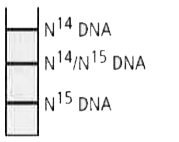E. coli cell grown on 15N medium are transferred to 14N medium and allowed to grow for two generations. DNA extracted from these cells is ultracentrifuged in a cesium chloride ensity gradient. What density distribution of DNA would you expect in this experiment?Solution in Tamil
One high and one low density band
One Intermediate density band
One high and one intermediate density
One low and one intermediate density band
The correct Answer is:D
Step by step video, text & image solution for E. coli cell grown on ""^(15)N medium are transferred to ""^(14)N medium and allowed to grow for two generations. DNA extracted from these cells is ultracentrifuged in a cesium chloride ensity gradient. What density distribution of DNA would you expect in this experiment? by Biology experts to help you in doubts & scoring excellent marks in Class 11 exams.
Updated on:21/07/2023Similar Questions
E. coli cell grown on ""^(15)N medium are transferred to ""^(14)N medium and allowed to grow for two generations. DNA extracted from these cells is ultracentrifuged in a cesium chloride ensity gradient. What density distribution of DNA would you expect in this experiment?
View SolutionDNA प्रतिकृतिकरण की अर्द्ध-संरक्षी प्रकृति को मीसेल्सन और स्थाल ने अपने बैक्टीरिया के साथ प्रयोगों में स्थापित किया। उन्होंने, बैक्टीरिया को N15−NH4CI माध्यम में उगाया, धोया और फिर N14 युक्त यौगिकों वाले ताजे माध्यम में इनक्यूबेट किया और उसे तीन पीढ़ियों तक बढ़ने दिया। विलगित DNA के CsCl घनत्व प्रवणता अपकेन्द्रण ने DNA प्रतिकृतिकरण की अर्द्ध-संरक्षी प्रकृति को स्थापित किया। नीचे दिया गया चित्रात्मक आरेख CsCIघनत्व प्रवणता में विभिन्न रूप से नामांकित DNA की स्थिति को दर्शाता है।

यदि DNA प्रतिकृतिकरण संरक्षी होता तो प्रतिरूप क्या होता?
View Solutionएश्चेरिचिया कोलाई की कोशिकाएँ उस माध्यम में कई पीढ़ियों के लिए विकसित की गई जिसमें एकमात्र उपलब्ध नाइटोजन भारी समस्थानिक 15N है। इसके पश्चात् उन्हें 14N वाले एकमात्र नाइट्रोजन रखने वाले माध्यम में स्थानान्तरित किया गया। उन कोशिकाओं के DNA अणुओं में 15N व 14N का कितना वितरण (Distribution) अपेक्षित रहेगा, जिन्हें 14N निहित रखने वाले माध्यम में एक पीढ़ी के लिए यह मानते हुए उगाया गया कि रेप्लीकेशन था-
(i) कन्जरवेटिव (ii) सेमीकन्जर्वेटिव (iii) डिसपर्सिव?
View SolutionA DNA molecule in E. coli is heavy and labelled with N15. Iit is allowed to replicate in a medium containing N14. After one generation of replication, the two daughter molecules will
View SolutionA heavy DNA (N^(15)N^(15)) of E. coli is allowed to replicated in N^(14) medium for 80 minutes. What would be the proportions of light (N^(14)-N^(14)) and hybrid densities of DNA (N^(14)-N^(15)) molecules?
View SolutionIf E.coli containing N15−N15 DNA was allowed to grow for 80 minutes in medium containing N14 then, what would be the percentage of light density and hybrid density DNA molecule ?
View SolutionIf hybrid DNA is allowed to replicate for one generation in medium containing N14 and for second generation in medium containing N15 then what is the proportion of light , heavy and hydrid DNA obtained respectively?
View SolutionA DNA molecule in E. coli is heavy and labelled with N15. Iit is allowed to replicate in a medium containing N14. After one generation of replication, the two daughter molecules will
View Solution
